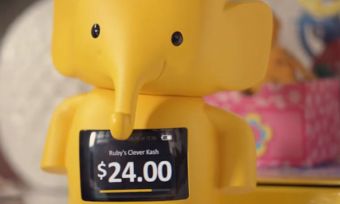According to research, the money habits you have as an adult have been set by the time you reach the age of seven. Experts at Cambridge University found that by age seven, most children have grasped how to recognise the value of money, how to count it, that money is exchanged for goods, what it means to earn money and what income is. But they also point out the importance of parents’ role in fostering these money lessons in children.
But financial concepts are often complicated enough to understand, let alone explain to children. That’s why finding the right approach to engage children in money lessons is key. In this guide, we cover a few simple ways you can approach talking about money, including money games for kids and all-important lessons around purchase choices.
Encouraging young children to save
A key strategy when helping children understand money is to ensure they’re involved in a goal-tracking process. If they can’t see how well they are getting on with their money goals, it’s hard for them to understand what they’re working towards. With the use of physical cash declining, finding a way to show a child how their savings are building up is getting harder. Fortunately, banks and other financial providers are aware of this challenge and have been creating digital savings options geared towards children, such as ASB’s digital money box, Clever Kash, or Westpac’s app Cash Critter.
Aside from the digital money boxes and apps, just the act of involving children in conversations about money can help with their financial literacy. Of course, we don’t mean you need to try to explain the finer details of compound interest or of keeping on top of credit card debt to your primary school children, but you can still help them understand that treats, such as holidays, require self-discipline to obtain. It all comes back to the old trick of offering a child one lolly now, or two if they wait for a certain period of time. Helping them understand the concept of delayed gratification can go a long way to creating positive money habits.
Using money games for kids
One way to get children engaged in the process of understanding money is to use some simple money games, ASB suggests. For example, you could get children to line up coins and notes in order of smallest to biggest. Or give the child a stack of coins and a separate stack of notes and help them figure out which stack is worth more. For more info on ASB’s money tips for children, see the bank’s video, below.
Helping children to understand opportunity cost
Basically, there are situations where you might not be able to have your cake and eat it, too, and it’s an important financial lesson for children.
Here is a definition of opportunity cost, as provided by Investopedia:
“Opportunity costs represent the benefits an individual, investor or business misses out on when choosing one alternative over another.”
Opportunity cost decisions are basically trade-offs – the other possible choices that evaporate the moment you make a decision – and are part of daily life.
When it comes to teaching children about opportunity cost, try giving them some simple examples based on the choices they make. For example, if a grandparent has given them $5 to buy an ice-cream, but they decide to buy a Lego minifigure instead, make them aware that their decision will lead to an ice-cream-less near future!
Encouraging an entrepreneurial spirit
The thrill that comes by receiving money for a job well done is one that children can appreciate from a young age. Earning pocket money through performing chores is a simple way to teach the value of hard work, but another great lesson is to show how money can be used to make more money.
All kids love lemonade, cookies and cupcakes, and the opportunity to set up their own neighbourhood food stall is one they never turn down. But instead of supplying the ingredients for free, get them to go shopping with their saved pocket money. Watching how $10 of ingredients can be transformed into $30 of profits in an afternoon is the perfect way to teach the basics of investing.
These simple lessons could provide the impetus to get your children saving and learning about money and set a solid foundation for healthy money habits down the track.
If you’re in the market for a savings account for your child, don’t forget to check out what is available on the market, first. Canstar compares savings accounts – and savings account providers – in New Zealand, to see how they compare on fees, rates and features. Have a look at Canstar’s free comparison tools, to help you narrow down a shortlist of options.




Share this article